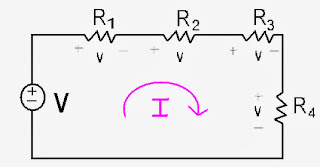Series Resistors
Resistors are connected in series when they are chained together in a single line. all the current flowing from one resistor will also pass the other resistors and has no other way to go because they have only path.
Resistors are connected in series when they are chained together in a single line. all the current flowing from one resistor will also pass the other resistors and has no other way to go because they have only path.
In this circuit we have four resistors and one voltage source. All we need to do is to follow the following formulas:
Resistance: Req = R1 + R2 + R3 +………………Rn
Voltage: Veq = V1 + V2 + V3+...…...Vn
Current: Ieq = I1 = I2 = I3 = …….....…..In
Voltage Division
Parallel Resistors
Resistance: Req = R1 + R2 + R3 +………………Rn
Voltage: Veq = V1 + V2 + V3+...…...Vn
Current: Ieq = I1 = I2 = I3 = …….....…..In
In solving by voltage division we must remember that the circuit contains two resistors and one voltage source connected in series.
voltage division formula:
V1 is voltage from R1 as well as V2. V in the numerator is the voltage source.
Parallel Resistors
A resistor is in parallel to another resistor if and only if they share common terminals. In our circuit Both the branches touch each other's endpoint.
formula:
Current Division





















